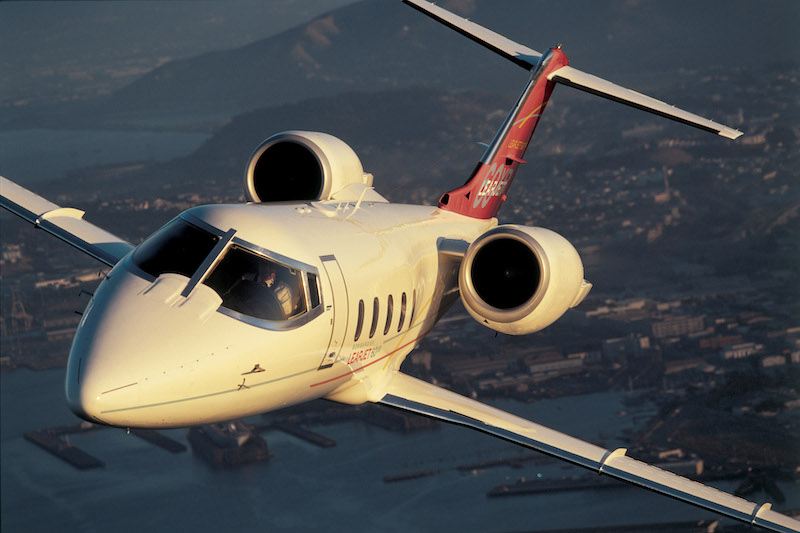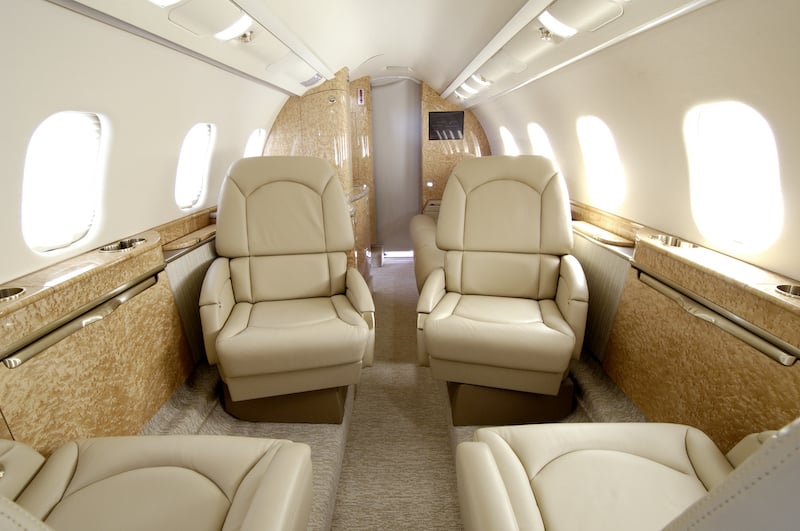
The FAA certified the Learjet 60 in January 1993.
When Bombardier bought Learjet from Integrated Resources in mid-1990, it was clear that it needed to quickly and affordably bring to market new products to boost sales.
Learjet was on borrowed time, barely able to keep the doors open. Headquarters in Montréal immediately gave the go-ahead to develop the Model 60, a major iteration of the 1981 Learjet 55. Model 60 development cost was pegged at less than $100 million and it could be certified in fewer than three years.
The Learjet 55 lacked market appeal. It had a short, cramped cabin and doggy performance, especially when departing warm-day airports because of its over-taxed TFE731-3 turbofans. It needed a much longer cabin to make it competitive with the Hawker 800 and genuine Learjet performance to distinguish it from the Cessna Citation III, also powered by TFE731-3 engines.
Therefore, Bill Greer, Learjet vice president of engineering, turned to Pratt & Whitney Canada to power a Learjet for the first time in company history. The Learjet 60 was fitted with highly flat-rated 4,600-lb.-thrust Pratt & Whitney Canada PW305A turbofans, enabling the new model to reach to FL410 in 18 min. and thus restoring the brand’s reputation for best-in-class climb performance.
Cabin Dimensions
The pair of PW305A engines added 600 lb. of weight compared to the Model 55’s brace of TFE731-3 turbofans. To offset the added heft, Learjet stretched the fuselage 43 in. This also lengthened the cabin to make room for six to seven passengers plus a full-width aft lavatory. Even with the stretch, the cabin 2 ft. to 5 ft. shorter than most midsize competitors. But buyers liked Learjet 60’s comfortable cross-section, considerably larger than either Citation III or G100. Overall cabin volume, however, is 447 ft.3versus 600 ft.3 for a Hawker 800.
The more fuel efficient PW305As, subtle aerodynamic refinements that reduced drag by 4% compared to Model 55 and a one-third-larger fuselage fuel tank increased theoretical max range to nearly 2,400 nm (2,762 mi.), a 350 nm improvement over its predecessor. Typically equipped, Model 60-series aircraft can fly four passengers 2,200 mi. and land with National Business Aviation Association instrument flight rules reserves.
If all seven seats are occupied, accommodating passenger baggage may pose challenges. The Learjet 60 has a 24-ft.3 aft external baggage compartment. Another 24 ft.3 of luggage can be loaded into the lavatory area.
It is important to note that while the toilet is externally serviced, it is advisable to refill the blue juice from inside the lavatory compartment to avoid overflowing the reservoir. The emergency exit door in the lavatory swings open to ease the task.
A four-tube, Collins Pro Line 4 avionics package was standard, with most buyers opting to install extra-cost dual Universal UNS-1B flight management systems (FMS) due to limited capabilities of the standard Collins AMS-850 long-range navigation systems.
Early aircraft suffered plenty of teething pains, including some troublesome engine components, weak batteries, short-lived, two-disc brakes and a nose-heavy center of gravity (CG) that limited loading flexibility. The aircraft also were not offered with a promised auxiliary power unit (APU), and Learjet struggled to find a solution. Virtually all the aircraft’s major shortcomings were resolved by a series of service bulletins and a DeCrane (née PATS) supplemental type certificate for a Sundstrand TurboMach APU installation (for ground use only).
In 2004, the Learjet 60SE made its debut, featuring an increased maximum takeoff weight, standard APU and traffic collision avoidance system, plus the Enhanced Ground Proximity Warning System, a plusher interior and upgraded inflight entertainment system. Triple-disc brakes provide more confident stopping power and five to six times the overhaul interval of the two-disc brakes. Unfortunately, Bombardier never retested Model 60’s runway performance to take credit for the increased stopping power.
XR Enhancements
The Learjet 60XR arrived in late 2007, providing a fully integrated Collins Pro Line 21 avionics suite, including full-function FMS-5000, an engine-indicating and crew-alerting system, a choice of five floor plans and popular options including XM Radio weather, 3D moving maps and third very high frequency communications radio. Its increased basic operating weight limits the tanks-full payload to 660 lb.

From a pilot’s standpoint, aircraft acceleration and climb performance are exhilarating. It is a nice handling aircraft, in BCA’s opinion, with gentle stall characteristics due to large “Delta” anhedral fins on the tail. However, the aircraft gets noticeably nose-heavy due to forward CG shift as up to 5,010 lb. of aft fuselage tank fuel is consumed. During preflight planning, it is critical to check CG shift caused by fuel burn.
Despite its sleek looks, the Model 60 is not a high-altitude, high-Mach speedster. Normal cruise speed is 0.76 Mach at FL410 to FL430. Long-range cruise is 0.72 Mach. From FL370 to FL430, maximum Mach number is cut back from 0.81 Mach to 0.78 Mach to meet required Mach buffet margins. This is due to excessive wing loading of the 265-ft.2 airfoil, one with a basic shape inherited from the mid-1960’s Learjet 23.
Even so, the jet has good fuel efficiency and quick block times because of strong climb performance. Plan on burning 1,800 lb. per hour for the first hour, 1,400 lb. during the second hour, 1,300 lb. for the third hour and 1,200 for the fourth. Push it above 0.76 Mach, though, and fuel efficiency suffers due to Mach effects.
The comparatively small wing and diminutive wheels, tires and brakes also result in relatively high V speeds and long runway requirements. For mid-weight missions, many Learjet 60 pilots use the “5-6-7” minimum runway length rule for low elevation airports: 5,000 ft. dry, 6,000 ft. wet and 7,000 ft. contaminated. At MTOW, sea-level, standard-day takeoff field length is 5,450 ft. Up at BCA’s 5,000 ft. elevation, ISA+20°C airport, you will need 8,520 ft. of pavement.
Keeping tires properly inflated is critical to flight safety. An ongoing airworthiness directive requires tire pressures to be checked every 96 hr. A blown tire on a heavy-weight takeoff can put the aircraft at critical risk for a serious or fatal accident.
Maintenance Considerations
Operators tell BCA that main wheel tires only last 150 to 200 landings. When the tires are changed, the wheel halves and through-bolts must undergo non-destructive testing to assure structural integrity. Budget $12,000 for the event. The three-disc brakes last 800 to 1,400 landings. Plan on $66,500 to overhaul the heat packs, according to David Turner, direct of maintenance at AB Jets.
Engine reserves also are pricey, running roughly $1,000 per hour for both PW305As, Turner says. But block times on typical missions are quicker than other midsize jets, so cost-per-mile is attractive. Plan on spending $3,750 to $3,850 per hour for direct operating costs.
Aircraft reliability is a strong suit, and Learjet 60 seldom visits the shop between 300-hr./12-month maintenance intervals. Those inspections can be done in 16 to 24 maintenance staff hours. There also are 600-hr./ 24-month and 900-hr./48-month inspections that take about 80 hr. and 240 hr., respectively. There is a 96-month inspection, as well.

As with other Learjets, the 12-year inspection is a major event, requiring at least six weeks in the shop for a comprehensive look at the airframe. Budget $250,000 for the basic 12-year inspection. If corrosion is discovered, a wing demate may be required, causing repair costs potentially to soar. That can add another month to shop time—and parts availability from Bombardier can be challenging.
About 10% of the active fleet is on the resale market. Currently, there are 258 Learjet 60s and 60SEs, built from 1993 to 2007, still in service, according to Gavin Woodman, co-founder of Aerocor brokerage firm. There are 109 Learjet 60XRs, produced from 2007 to 2013, actively flying.
Model 60s, enrolled in Pratt & Whitney Canada’s Eagle Service Plan, resell for $1.15 million for 1993 models up to $2.4 million for 2004 models, according to the VREF aircraft value reference guide. Learjet 60SE aircraft, built from 2004 to 2007, retail for $2.5 million to $2.7 million, according to VREF. And Learjet 60XR resale prices range from $3.4 million to $5 million.
Most other midsize aircraft offer more cabin room and better runway performance. But nothing can touch Learjet 60-series jets’ sporty performance and panache, putting this midsize aircraft into a class of its own.
BCA welcomes comment and insight from aircraft dealers and brokers for its monthly 20/Twenty pre-owned aircraft market feature. The focus aircraft for July is the Gulfstream G650 and for August, the De Havilland Twin Otter. To participate, contact [email protected].





